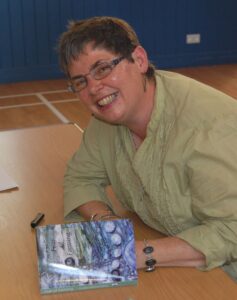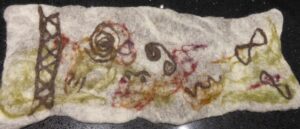One of the advantages of reaching my advanced age is being sent some nice books to review. You can catch my thoughts on a nice new Mesolithic book here.
Tag: Book Review
Archaeology as Muse

Archaeology is important to me. I just love it when it permeates everyday culture. It is a justification in my mind of its significance as an artefact, itself contributing to the way we live now. Continue reading Archaeology as Muse
Mezolith – Book Review
As you might have gathered one of my passions is integrating archaeology, and particularly Mesolithic archaeology, into everyday life. By happy chance I was invited to review the two Mezolith graphic novels which do just that. You can read my review in the most recent issue of Mesolithic Miscellany (volume 24.2) which is free to download here, or to view online here. You need to scroll towards the end of the journal. If you are a fan of graphic novels, or the Mesolithic, I recommend getting hold of these two books!
Book Review: Art and Architecture in Neolithic Orkney: Process, Temporality and Context

I was recently asked to review a book on Neolithic Orkney for our local paper, The Orcadian, and, while there is a great online version, it occurred to me that it might be of interest to those who read the blog so, with kind permission of Sigurd Towrie, the editor, I am posting it here.
Art and Architecture in Neolithic Orkney: Process, Temporality and Context.
Antonia Thomas. Archaeopress. 2016 (available in hard copy or as an ebook)
We are all used to reading media snippets about amazing structures and spectacular artefacts from Orkney’s Neolithic past. How refreshing therefore to have a whole book devoted to one aspect in detail. Even more exciting: a book that takes information from our newest and most enigmatic site at Ness of Brodgar, and puts it into context with information from two of our oldest sites: Skara Brae and Maeshowe. Finally, and the icing on the cake, it is readable.
Art and Architecture in Neolithic Orkney is a handsome volume; it is well illustrated and clearly set out. It is designed to be read from cover to cover but in fact there is a lot of detail here and it also makes for an excellent ‘dipping’ book. The main thrust, as you might guess, is to provide an overview of the amazing suite of decorated stones found within the structures of Neolithic Orkney through detailed studies of these three key sites. Within each site, particular case studies are set out.
It is a comprehensive piece of work, taking us first through a history of the archaeological study of art, and then providing a brief guide to the Neolithic art of Britain and Ireland. This helps to put Orkney art into context, though one cannot help wondering, given the thoroughness of the present research and the ephemeral nature of many of the pieces recorded, whether decorated stones might be underrepresented outside of Orkney. Many of the pieces here were unknown before Thomas’ research.
We are led deeper into a fascinating detailed consideration of the individual sites. With regard to Skara Brae and Ness of Brodgar a wealth of useful material is provided, including up-to-date breakdowns of the architectural remains and stratigraphy. Even for Maeshowe, a site which you might think had been well published in all its glory, Thomas finds angles and information that have not been presented before.
After this is it time for some serious discussion and analysis. In common with archaeological thought today, Thomas has moved far beyond the old-fashioned ‘Art Historical’ approach and even beyond the ‘Technological/Functional’ approach that was all the rage when I graduated. You won’t find an explanation of ‘meaning’, nor detailed discussions of manufacture, but hopefully any disappointment will be assuaged by learning new ways of thinking about the pieces. Rather than focusing on possible interpretations of Neolithic Art as a sort of code from the past, Thomas teaches us to consider the ways in which it was used and how it may have functioned as part of everyday life.
This is done through three different examinations: first, the processes of incorporating material into Neolithic structures; second, the lifespan (often brief) of art as a visible element; and third the wider context of community and identity in Neolithic Orkney. We are never going to know exactly what the makers of the ‘Brodgar Butterfly’ or the Skara Brae Lozenges meant by them, just as we don’t know what Leonardo intended to convey in the Mona Lisa’s smile, or Banksy with his graffiti. But we can start to think about the roles that these pieces of art played in relationship to their surroundings and those who frequented them.
In this way, Thomas has identified very specific and differing forms of creation and deposition. For me perhaps the most surprising elements are the ways in which design appears to be less important than creation, and existence more important than visibility. Is this indeed ‘art’ as we understand it? Only in the way in which a hidden tattoo or plasterer’s doodle might be so defined.
There is a lot to take in. There is a lot to think about. It is a book that will linger and enrich any exploration of the remains of Neolithic Orkney. The ‘art’ itself is just wonderful, it was clearly an integral part of the lives of our Neolithic ancestors. I can’t help a slight regret that I’m still so far from ‘reading’ it, but I now know so much more about those who tramped the passages and halls of the past. I’m happy.
The book is based on Antonia Thomas’ PhD thesis (itself an exemplary piece of work I am told), and she has done an impressive job, not just in completing the thesis but in producing a publication less than a year after attaining her doctorate. It marks the inauguration of the Archaeology Institute’s Research Publications, judging by the ongoing projects in the Institute one can only wait with excitement for the next volumes in the series. Meanwhile, if you have an interest in the lives of those who lived and farmed in Orkney five thousand years ago, I urge you to go out and buy it.
You must be logged in to post a comment.